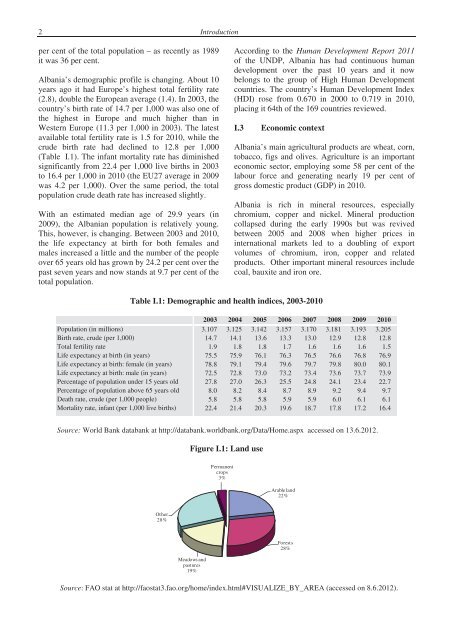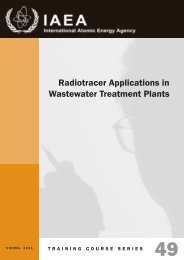Second Environmental Performance Review of Albania
Second Environmental Performance Review of Albania
Second Environmental Performance Review of Albania
You also want an ePaper? Increase the reach of your titles
YUMPU automatically turns print PDFs into web optimized ePapers that Google loves.
2 Introductionper cent <strong>of</strong> the total population – as recently as 1989it was 36 per cent.<strong>Albania</strong>’s demographic pr<strong>of</strong>ile is changing. About 10years ago it had Europe’s highest total fertility rate(2.8), double the European average (1.4). In 2003, thecountry’s birth rate <strong>of</strong> 14.7 per 1,000 was also one <strong>of</strong>the highest in Europe and much higher than inWestern Europe (11.3 per 1,000 in 2003). The latestavailable total fertility rate is 1.5 for 2010, while thecrude birth rate had declined to 12.8 per 1,000(Table I.1). The infant mortality rate has diminishedsignificantly from 22.4 per 1,000 live births in 2003to 16.4 per 1,000 in 2010 (the EU27 average in 2009was 4.2 per 1,000). Over the same period, the totalpopulation crude death rate has increased slightly.With an estimated median age <strong>of</strong> 29.9 years (in2009), the <strong>Albania</strong>n population is relatively young.This, however, is changing. Between 2003 and 2010,the life expectancy at birth for both females andmales increased a little and the number <strong>of</strong> the peopleover 65 years old has grown by 24.2 per cent over thepast seven years and now stands at 9.7 per cent <strong>of</strong> thetotal population.According to the Human Development Report 2011<strong>of</strong> the UNDP, <strong>Albania</strong> has had continuous humandevelopment over the past 10 years and it nowbelongs to the group <strong>of</strong> High Human Developmentcountries. The country’s Human Development Index(HDI) rose from 0.670 in 2000 to 0.719 in 2010,placing it 64th <strong>of</strong> the 169 countries reviewed.I.3 Economic context<strong>Albania</strong>’s main agricultural products are wheat, corn,tobacco, figs and olives. Agriculture is an importanteconomic sector, employing some 58 per cent <strong>of</strong> thelabour force and generating nearly 19 per cent <strong>of</strong>gross domestic product (GDP) in 2010.<strong>Albania</strong> is rich in mineral resources, especiallychromium, copper and nickel. Mineral productioncollapsed during the early 1990s but was revivedbetween 2005 and 2008 when higher prices ininternational markets led to a doubling <strong>of</strong> exportvolumes <strong>of</strong> chromium, iron, copper and relatedproducts. Other important mineral resources includecoal, bauxite and iron ore.Table I.1: Demographic and health indices, 2003-2010Population (in millions) Birth rate, crude (per 1,000)Total fertility rateLife expectancy at birth (in years)Life expectancy at birth: female (in years)Life expectancy at birth: male (in years)Percentage <strong>of</strong> population under 15 years oldPercentage <strong>of</strong> population above 65 years oldDeath rate, crude (per 1,000 people)Mortality rate, infant (per 1,000 live births)2003 2004 2005 2006 2007 2008 2009 20103.107 3.125 3.142 3.157 3.170 3.181 3.193 3.20514.7 14.1 13.6 13.3 13.0 12.9 12.8 12.81.9 1.8 1.8 1.7 1.6 1.6 1.6 1.575.5 75.9 76.1 76.3 76.5 76.6 76.8 76.978.8 79.1 79.4 79.6 79.7 79.8 80.0 80.172.5 72.8 73.0 73.2 73.4 73.6 73.7 73.927.8 27.0 26.3 25.5 24.8 24.1 23.4 22.78.0 8.2 8.4 8.7 8.9 9.2 9.4 9.75.8 5.8 5.8 5.9 5.9 6.0 6.1 6.122.4 21.4 20.3 19.6 18.7 17.8 17.2 16.4Source: World Bank databank at http://databank.worldbank.org/Data/Home.aspx accessed on 13.6.2012.Figure I.1: Land usePermanentcrops3%Arable land22%Other28%Meadows andpastures19%Forests28%Source: FAO stat at http://faostat3.fao.org/home/index.html#VISUALIZE_BY_AREA (accessed on 8.6.2012).
















